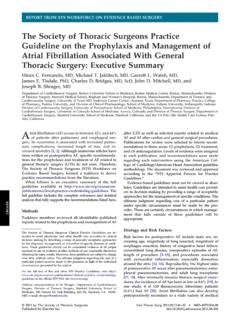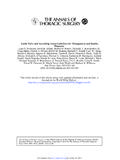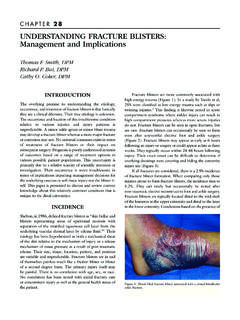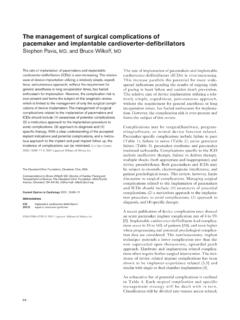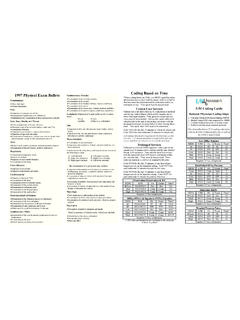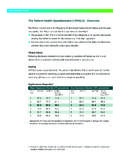Transcription of The Society of Thoracic Surgeons Expert …
1 STS Expert consensus STATEMENTThe Society of Thoracic Surgeons ExpertConsensus for the Resuscitation of PatientsWho Arrest After Cardiac SurgeryThe Society of Thoracic Surgeons Task Force on Resuscitation After Cardiac Surgery*Executive SummaryThe Society of Thoracic Surgeons Task Force on Resus-citation After Cardiac Surgery provides this professionalsociety perspective on resuscitation in patients who arrestafter cardiac surgery. This document was created using amultimodal methodology for evidence generation andincludes information from existing guidelines, from theInternational Liaison Committee on Resuscitation, fromour own structured literature reviews on issues particularto cardiac surgery, and from an international survey onresuscitation hosted by gathering evidence for this consensus paper,searches were conducted using the MEDLINE keywords cardiac surgery, resuscitation, guideline, thoracicsurgery, cardiac arrest.
2 And cardiac massage. Weightwas given to clinical studies in humans, although somecase studies, mannequin simulations of potential pro-tocols, and animal models were also was reached using a modified Delphimethod consisting of two rounds of voting until 75%agreement on appropriate wording and strength of theopinions was reached. The Society of Thoracic SurgeonsWorkforce on Critical Care was enlisted in this process toprovide a wider variety of experiences and backgroundsin an effort to reinforce the opinions start with the premise that external massage isineffective for an arrest due to tamponade or hypo-volemia (bleeding), and therefore these subsets ofpatients will receive inadequate cerebral perfusion dur-ing cardiac arrest in the absence of resternotomy.
3 Becausethese two situations are common causes for an arrestafter cardiac surgery, the inability to provide effectiveexternal cardiopulmonary resuscitation highlights theimportance of early emergency resternotomy within 5minutes. In addition, because internal massage ismore effective than external massage, it should be usedpreferentially if other quickly reversible causes are present a protocol for the cardiac arrest situationthat includes the following recommendations: (1) suc-cessful treatment of a patient who arrests after cardiacsurgery is a multidisciplinary activity with at least six keyroles that should be allocated and rehearsed as a team ona regular basis.
4 (2) patients who arrest with ventricularfibrillation should immediately receive three sequentialattempts at defibrillation before external cardiac massage,and if this fails, emergency resternotomy should be per-formed; (3) patients with asystole or extreme bradycardiashould undergo an attempt to pace if wires are availablebefore external cardiac massage, then optionally externalpacing followed by emergency resternotomy; and (4)pulseless electrical activity should receive prompt rest-ernotomy after quickly reversible causes are , we recommend that full doses of epinephrineshould not be routinely given owing to the danger ofextreme hypertension if a reversible cause is are given for excluding reversible airwayand breathing complications, for left ventricular assistdevice emergencies, for the nonsternotomy patient, andfor safe emergency resternotomy.
5 We believe that allcardiac units should have accredited policies and pro-tocols in place to specifically address the resuscitation ofpatients who arrest after cardiac surgery.(Ann Thorac Surg 2017;103:1005 20) 2017 by The Society of Thoracic SurgeonsThe American Heart Association (AHA) issued itslatest edition of guidelines for resuscitation inOctober 2015[1]. These guidelines do not providespecialist guidance for patients who arrest after cardiacsurgery. The European Resuscitation Council (ERC)guidelines were published simultaneously and, incontrast, included a detailed section on the resuscitationof patients who arrest after cardiac surgery[2].
6 TheERCguidelines recommend resternotomy within 5 minutes ofa cardiac arrest, allowing any trained practitioner to*A complete list of the authors for The Society of Thoracic Surgeons TaskForce on Resuscitation After Cardiac Surgery appears at the end of STS Executive Committee approved this correspondence to Dr Dunning, Department of CardiothoracicSurgery, James Cook University Hospital, Marton Rd, Middlesbrough TS43BW, United Kingdom; Dunning and Levine disclose a relationship withCALS-S UK Ltd. Dr Arora discloses afinancial rela-tionship with Pfizer and Mallinckrodt Pharmaceuticals.
7 2017 by The Society of Thoracic Surgeons0003-4975/$ by this task. They warn against full-doseepinephrine and allow external cardiac massage to bedeferred while three-stacked shocks are given or pacingis begun. The ERC guidelines fully support the guide-lines published by the European Association of Cardio- Thoracic Surgery in 2009[3]. These documents havestimulated many clinicians managing cardiac surgicalpatients to evaluate more carefully how cardiac arrestsare managed in their own units. There is now recogni-tion that patients having a cardiac arrest after cardiacsurgery are sufficiently different from patients in generalto warrant their own treatment algorithm to optimizetheir survival after year, more than 400,000 patients undergo car-diac surgery in the United States at one of approximately1,200 medical centers[4 6].
8 The incidence of cardiacarrest after cardiac surgery is to 8%[7 16].Themostremarkable statistic regarding these patients is theirrelatively good outcome. Approximately half survive tohospital discharge, a far higher proportion than isreported when cardiac arrest occurs in other for this superior survival include the high inci-dence of reversible causes of the cardiac (VF) is the cause of cardiac arrestin 25% to 50% of cases. In the intensive care unit (ICU)setting, that can be immediately identified and tamponade and major bleeding account foranother large percentage of the additional arrests.
9 Bothconditions can be quickly relieved by prompt resuscita-tion and emergency resternotomy to relieve tamponadeand control recognition and treatment by ICU staff trainedin the recognition and management of these arrests im-proves survival. Practicing protocol-based arrest man-agement has been shown to reduce by 50% the time tochest reopening and reduce complications resulting fromthe resternotomy after cardiac surgery[16 21].The protocol presented here addresses many issuesparticular to the cardiac surgical patient, including timingofemergency resternotomy, number of attempts at defibril-lation before resternotomy, administration of epinephrine,ventilator management, infusion and pacemaker settings,emergency resternotomy instrumentation sets, use of theintraaortic balloon pump (IABP), and cardiac arrests in thenon-ICU setting and under special circumstances.
10 Thisprotocol applies to all patients in the ICU, includingpediatric, minimal access, left ventricular assist device, andtransplant patients. It does not include patients undergoingpulmonary surgery. Issues regarding the treatment ofpatients in mixed specialty areas are the generation of The Society of Thoracic Surgeons (STS) Expert consensus statement, we support and followthe American College of Cardiology Foundation/AHAclinical practice guidelines methodology[22], includingthe grading of for Cardiac Surgical Patients in theIntensive Care UnitThe recommended modification of the AHA algorithm tobe applied in cases of cardiac arrest after cardiac surgeryis presented inFigure 1.
